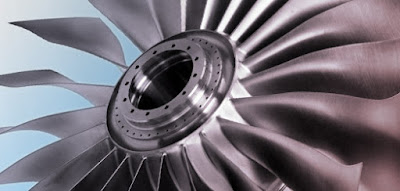Pressure conversion plays a very important role in gas turbine. Pressure gets converted from one form to another as the fluid flows through various sections of the turbine. There are two different kinds of pressure developed within. They are 1.) Static pressure
2.) Impact pressure
Static pressure is the pressure that the fluid exerts on the walls of the turbine when it is stationary. Example is the pressure stored in a football or the pressure exerted by water molecules on the walls of a container.
 |
| Pressure exerted by stationary fluid on the container |
Impact pressure on the other hand is the pressure exerted by a moving fluid on the walls of the turbine. The pressure felt when a moving object strikes you is an example. Total pressure is the sum of static and impact pressure as the name suggests. Hypothetically, it is considered to be a constant. But due to various frictional and heat losses, it can vary slightly.
 |
| Pressure exerted by moving fluid on a cylinder |
Now let's understand how the the pressure gets converted. In a compressor, the main objective is to compress the incoming air. In order to do so the velocity should be low and pressure should be high. For this purpose divergent ducts are used and this is where static pressure comes into play. The value of static pressure here is high and that of impact pressure is low. We also find a measurable rise in temperature in compression.
 |
| Representation of Bernoulli's principle |
However during expansion in turbine we need a high velocity and low pressure of the expanding gas so that it is sufficient enough to rotate the stationary blades. This is where impact pressure can be analyzed. To obtain a high velocity and low pressure, convergent ducts are used in exhaust. In case of expansion, a temperature drop is observed. The basis of the relation between pressure and velocity is Bernoulli's principle.






Comments
Post a Comment